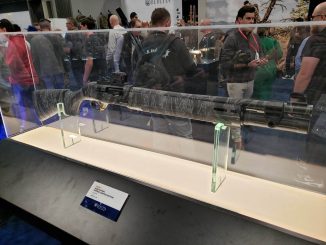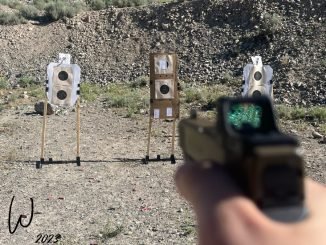
Recently I had the opportunity to appear on an episode of Primary & Secondary as part of a panel discussing holster selection. Check out the episode below, or directly on Youtube for the various ways to download the podcast.
While you’re at it, give some love to the other guests at their respective homes
Support My Work
If you made it this far, thanks for reading! Writing isn’t my full-time profession, and nearly everything I do comes out of my own pocket. Between ammunition, tuition, range fees and more, expenses add up fast. If you like what I have to offer, consider making a donation to my Patreon.
Every bit helps bring more work like this to you, and contributes to shortened timelines or more in-depth work on my part. You’ll also have more direct access to me, offering suggestions for future projects, looking behind the scenes, and getting early access to some content. You can find my Patreon >>HERE<<





This is really solid info, Daniel; thank-you very much for your insight!
I currently have been wearing a Trex Arms inner Velcro belt and it’s…okay, though a little soft. It is definitely softer than Blue Alphas Low Pro Inner Belt. I had one those and then it “shrunk”. Sold it because it was past the window for a return and it couldn’t be altered.
Additionally, the clunking I’ve experienced in the past with separate mag carriers/holsters is more than likely due to the Tier 1 Agis functionally sucking when used in a separate configuration with single clips. Because of that, I’ve tended to carry my spare mag with a +2 Floyd’s extension in a hip pocket with a NeoMag. This is okay, but not always viable as it cakes the mag with sand and lint if you don’t pay attention to your magazine’s status day-to-day (ask me how I know, though last range trip the gun ate the ammo up without flinching). This is where a mag pouch would aid In terms of debris entering the magazine.
For now, I’m trying out a DSG Apollo for my Shield Plus; Tom’s dark wing is definitely a good design!
I will look into the reviews that you’ve written about the belts you mentioned above, as well as the Blue Alpha reviews that were written.
Sidebar, do you have links/insight/shameless plugs for where to start firearms instruction?
I’ve attended a couple of local classroom discussions on concealed carry and basic firearms instruction, but most of my training has been confined to dry fire and a static range where drawing/reholstering is prohibited.
I think that’s everything for now…
I’m actually working on a piece with tips to help find better training. Unfortunately a lot of the local level instructors aren’t great. You get a lot of people from the NRA/USCCA papermills that don’t actually know much about guns, teaching, use of force, etc. We have a variety of reviews of classes we’ve taken here, and I have a handful over on Ammoland as well. Looking for people who regularly get training themselves, in addition to teaching is a good start, especially when the places they learn from are well known. A background in competition shooting can also help, ideally when they shoot something like USPSA/IDPA/ICORE/Steel Challenge where their rating is public. Instructor certifications from somewhere like Rangemaster, Modern Samurai Project, Sage Dynamics, DTI, Gunsite Academy, CTT Solutions, Massad Ayoob Group, etc are also indicative of better capabilities as an instructor, but also not a guarantee. The site firearmstraininghub.com has a fairly comprehensive list of national level instructors who should be able to help. A few places also offer virtual lessons for relatively cheap, such as Tatiana Whitlock.
Also, I forgot to mention, how to go about selected a truly good belt? I know it was alluded to in the video, but nothing was explicitly said in support of or against, say, ratchet-style belts like Kore/Nexbelt (both are social media influencer driven); or what about Velcro backed belts for “war belt” use/edc use combined?
I guess all of these questions stem from someone who really digs the value of the message you all contributed to the above video. Are there others available to listen to that kept the conversation going? Or was this just a one and done type of conversation?
Thank you, Daniel, as well as everyone else who was on the call for providing really solid insight into how to make a sound decision without feeling “pressured” by all of the hype that saturates the industry.
A good gun belt needs to be rigid enough to support your equipment without flopping over, which is the main factor when selecting one. That said, you can also go with something too rigid, which results in a sort of hula-hoop effect, where everything is sticking out, even though it is well supported. I haven’t used the ratchet style belts, so I cannot speak to their quality. I have worn the inner belt of the Blue Force Gear Double Layer belt as a standalone belt before, which works decently, but can be a little floppy if carrying a heavier pistol, and the material can sometimes catch on things.
For a leather belt I have really liked the Magpul Tejas, which I’ve owned for about six or seven years now. It’s nice enough that I wore it to a corporate job and often received compliments, but also has stood up to serious abuse on the range. Blue Alpha belts makes a pretty good series of nylon belts, a few of which I’ve worn. My current belt is the Foundation from EDC Belt Co, which mixes both rigid and soft sections to support the gun while also being more comfortable than most of the competition. I have written a review of the Tejas here, and Ally Corless has reviewed those Blue Alpha options here as well. I have reviewed the Foundation on Ammoland, which should pop up if you search the belt and my name.
Lucky Gunner has a good video on belt selection which is a few years old. The Suited Shootist does good content about conceal carry in fairly normal clothing on Youtube and Instagram. Topics like this come up from time to time in the some of the Primary & Secondary Facebook groups, and the PHLster Concealment Workshop group can sometimes be helpful as well. Greg Ellifritz of Active Response Training, and Darryl Bolke at DB’s Shooting Adventures also speak to conceal carry for more “normal” people as well.
I have taken the past couple of days to listen to this video in chunks; the short of it is that I fall into the same camp of having a bad experience with a sidecar style of holster (Tier 1 Agis). However, it was better (and safer) than other nylon sock offerings that I’d previously tried, in addition to an Incog. My question(s) are: how can I make a separate mag pouch work well IWB at the 11:00 range without it “clunking” into my holster? Also, as an M&P carrier, how might I consider the next “buying” decision between DSG, JMCK, Phlster, or Henry? It feels a little bit like “analysis paralysis” and I would like to make a sound investment in the right option without wasting money.
I think you we be equally served between PHLster, DSG, Henry, or JMCK. The first three are all made in the same place and enjoy very closing working relations, so the holsters are fairly similar in my experience. I like JMCK the best of the three because I can do a little more customization to the holster, but something like PHLster is a more streamlined offering and often can ship more quickly.
For spare magazines, I really like the IWB magazine pouch from Snake Eater Tactical, as well as the IWB Verticle from Bawidamann. The SET carrier is basically elastic and nylon, which is very slim and easy to carry, while also being very inexpensive. Though the shortcoming is that it is nearly impossible to re-index a magazine into it without taking the pouch off. The Bawidamann carrier is kydex, so it’s more rigid, but offers slightly adjustable retention, adjustable ride height, and you can insert a magazine while wearing it. To avoid thinks clunking into your holster I would mostly just work on adjusting their placement along your waistband to give them a little bit of room between the two. The softer Snake Eater Tactical pouch shouldn’t make much, if any, noise if they collide.
For a few years I also carried a SOFTT-W tourniquet at the 12o’clock position in a Snake Eater Tactical Rifle Magazine pouch, which gave some softer material between the gun and magazine to help reduce andy clunking. Additionally, I typically prefer to use a magazine extension, such as those offered by Arredondo, when carrying a spare magazine. These give me a little more to grab onto when I draw the magazine, and have more rounded edges than a normal magazine base plate, which helps with comfort over long days.